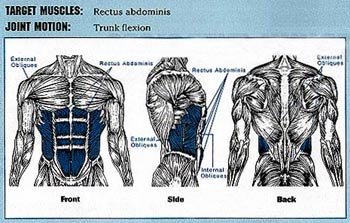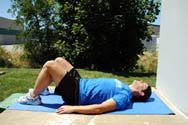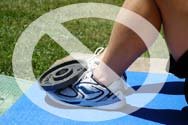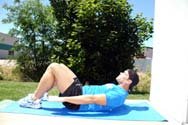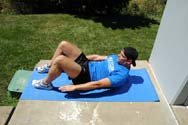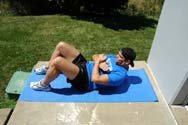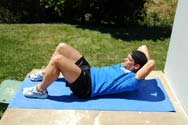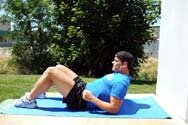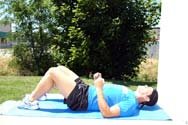While the ab-craze seems to be the new American pastime, the average person's midsection still looks more like an airbag than a washboard.
The main purpose of the crunch is to strengthen the abdominal muscles by challenging the abdominal group: the rectus abdominus muscles (two thin strips of muscle that extend from the breastbone to the pelvis), and the three deep layers of muscle that flank it.

Oblique & Rectus Muscles
|
Muscle
|
Origin
|
Insertion
|
Action
|
Innervation
|
| Rectus Abdominus | Superior surface of pubis around symphysis | Inferior surfaces of costal cartilages(ribs 5-7) and xiphoid process of sternum | Depresses ribs, flexes vertebral column | Thoracic spinal nerves (T7-T12) |
| Transversus Abdominus | Cartilages of the lower ribs, iliac crest, and lumbodorsal fascia | Linea alba and pubis | Compresses Abdomen | Intercostal iliohypogastric and ilioinguinal nerves |
| External Oblique | External and inferior borders of ribs 5-12 | Linea alba and iliac crest | Compresses abdomen; depresses ribs; flexes, bends to side, or rotates spine | Intercostal iliohypogastric and ilioinguinal nerves |
| Internal Oblique | Lumbodorsal fascia and iliac crest | Inferior surfaces of ribs 9-12, costal cartilages 8-10, linea alba, and pubis | Compresses abdomen; depresses ribs; flexes; bends to side, or rotates spine | Intercostal iliohypogastirc and ilioinguinal nerves |
Reprinted by permission from Everett Aaberg, 1998, Muscle Mechanics (Champaign, IL: Human Kinetics), 60.

Avoid Common Pitfalls
Great care and excellent technique is required to strengthen the abdominal muscles with crunches. In order to be an effective tool, crunches must pull the torso upward from a lying position toward the knees utilizing only the abdominal group. With poor technique, other muscles (those that flex the legs and hips) end up doing much of the work. This is especially evident with straight leg raises or sit-ups.
Bending the knees during the crunch helps neutralize the action of the hip flexors. This places more of the emphasis on the abdominal group. Even so, the abdominal group tends to be involved only in the initial phase of the crunch, after which the hip flexors take over. Furthermore, crunches done rapidly incorporating momentum, knees bent or not, do not work the abdominal group very effectively. Raising slowly, only part way will work the abdominal muscles most effectively.
 When doing crunches, never push through back pain! Stop immediately at even the slightest indication of lower back pain.
When doing crunches, never push through back pain! Stop immediately at even the slightest indication of lower back pain.
The abdominal muscles are no different than any other muscle group when it comes to strength training. It is not optimal to train them on consecutive days and with very high repetitions. Always give them at least one day of rest to allow them to recover and grow stronger. Keep your repetitions per set under 15 or so.
Strengthening the abdominal group will not remove fat from the waistline. There is no such thing as spot reduction. Muscles do not fuel exercise by using only the fat that surrounds them. Instead, during exercise the body tends to mobilize fat from storage depots throughout the body.
In addition, strength-training exercises such as the crunch are almost entirely anaerobic in nature. Anaerobic exercise does not use fat as a fuel, but aerobic exercise does. A brisk aerobic walk or jog is a much more effective way of burning body fat calories. Although abdominal strengthening may make the waistline appear narrower due to improved muscle tone, it will not remove body fat from the waistline.

Exercise Description
The crunch is a multiple-joint motion exercise designed to target the abdominals, particularly the rectus abdominus. Equal contractions from the obliques assist in providing a straight flexion of the trunk. Any combination of these muscular contractions can be performed to change which part of the abdominals will be targeted.
- Lie on your back on a padded surface, bending your knees to about 90 degrees with your feet flat on the floor. Do not anchor your feet, because doing so will bring leg and hip flexor muscles into action.
- Choose the position of your hands and arms according to your abdominal strength. The closer your hands are to your head, the more difficult the crunch becomes. As a beginner, rest your hands at your sides.
When you get stronger, you can cross your arms across your chest.
Eventually, cross your arms behind your head with each hand on the opposite shoulder if possible.
- Do not interlace your fingers behind your head. This can lead to stress on the neck and may cause injury
- Start each movement slowly, as if you were in slow motion.
- Focus on using your abdominal muscles only. Close your eyes and visualize the abdominal muscles tensing and shortening like slow-moving cables through a pulley that draws your shoulders and head off the floor.
- Exhale while the abdominal muscles contract and pull you upward. This will suck the muscles inward, thus ensuring involvement of the deeper muscles. Inhaling during the concentric phase may cause your abdomen to protrude, leading to overarching and strain of the lower back.
- Stop about halfway up (top of shoulder blades about 6 inches off the floor), and tense your abdominal muscles. Hold this position briefly and then slowly lower to the floor.
- Upon returning to the starting position, touch the floor lightly with your upper back and head, keeping the abdominal muscles tense.
 Video Of Crunch
Video Of Crunch
 MPEG (1.4 MB)
MPEG (1.4 MB)
 Windows Media (56 KB)
Windows Media (56 KB)
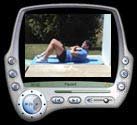
- If you find that this is too difficult, try doing only the curl-down phase. Assume a sitting position by pushing yourself upward with your arms. Slowly lower to the floor keeping the abdominals tensed.
 Video Of
Video Of Curl Down Only Crunch
Curl Down Only Crunch
 MPEG (986 KB)
MPEG (986 KB)
 Windows Media (43 KB)
Windows Media (43 KB)
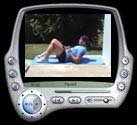
- Be patient, don't overdo it. One set of 5 properly executed crunches or curl downs is enough at first.
- Add 1 crunch each workout until you reach 15, then add more sets. When you can do three sets of 15, change your hand positions to add resistance.
- Keep in mind that the crunch heavily involves all the muscles of the abdomen, not just the rectus abdominus. For this reason it is not essential to do side bends, trunk twists or other "oblique targeting" exercises in addition to the crunch.
Nothing can replace hard work or perseverance, so get out there and get to it.
If you have any comments about this article feel free to contact me at patrick@issaonline.com.

